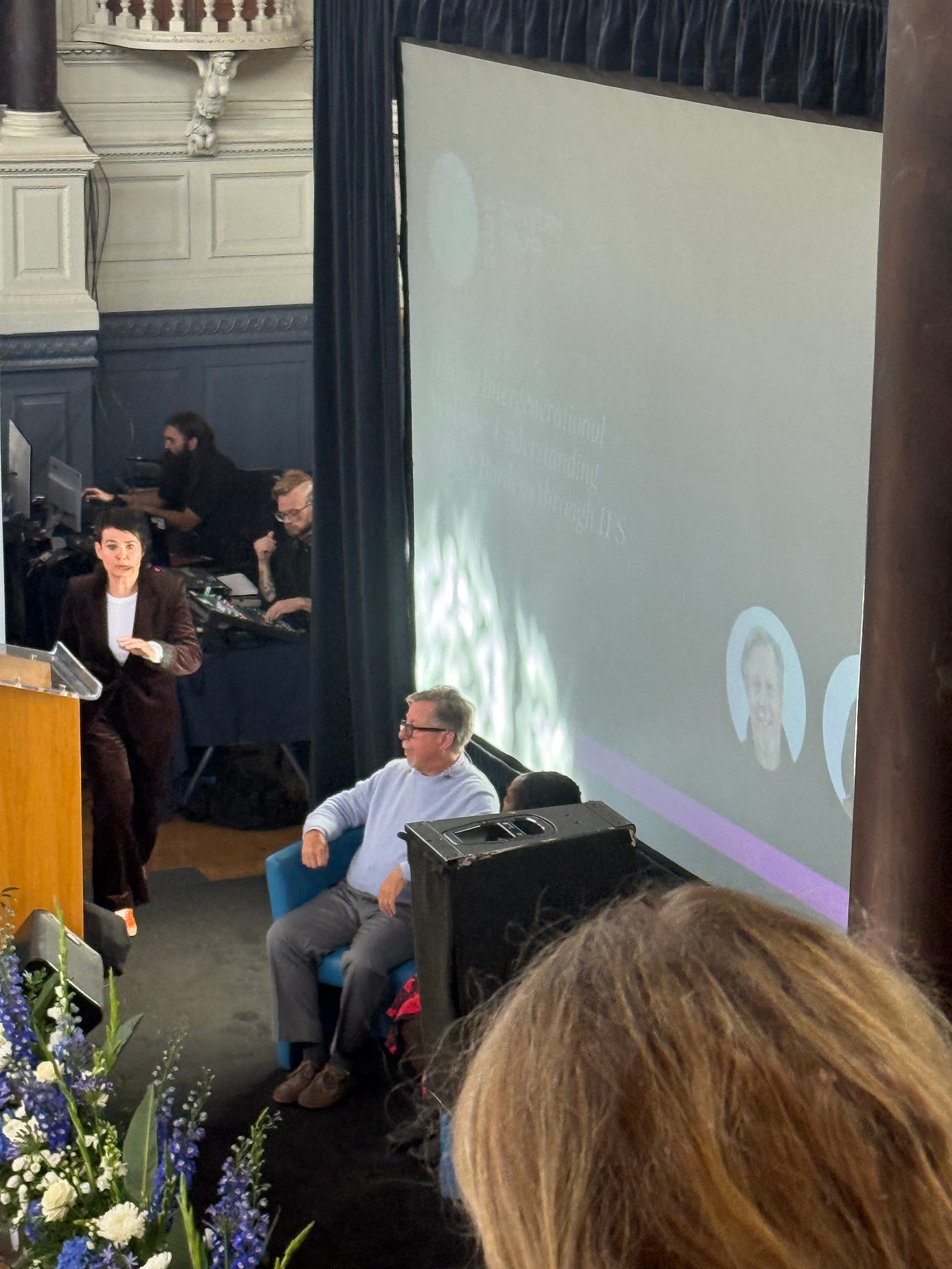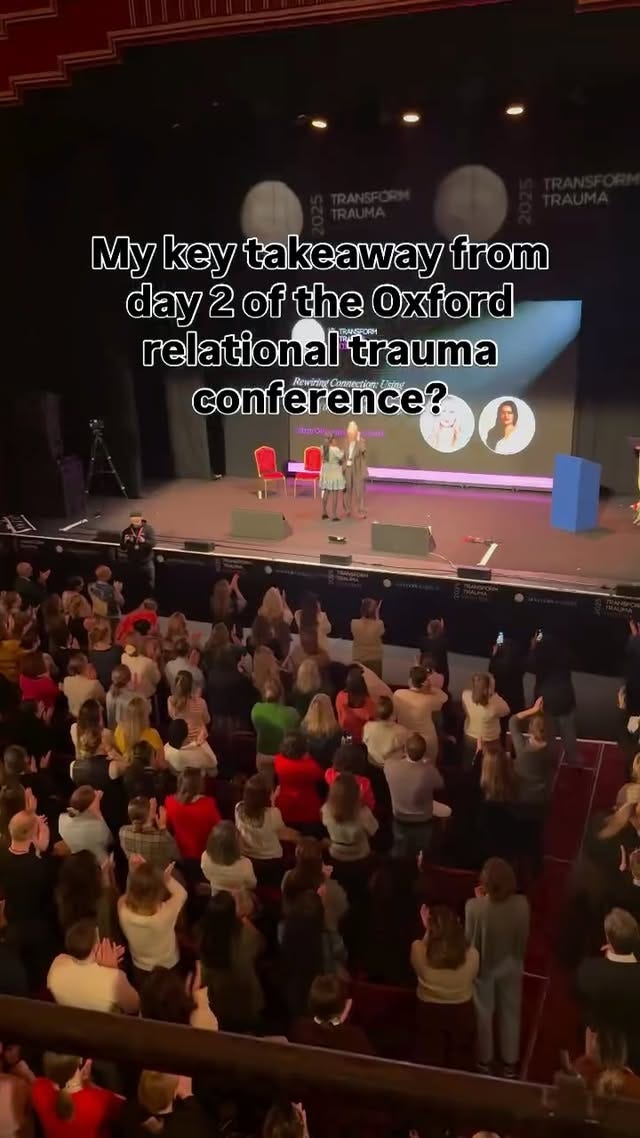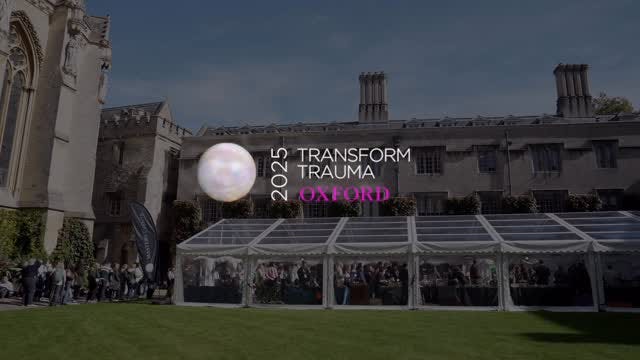Five Big Ideas from the Oxford Trauma Conference 2025 for Therapists
Key takeaways and clinical reflections for therapists from Richard Schwartz, Bessel van der Kolk, and more.
I’ve just returned from the Oxford Trauma Conference 2025, and my head is buzzing with ideas! Much of what was spoken about is not taught in courses, and it left me reflecting deeply on my own practice. Trauma therapy is evolving quickly, and the conversations at Oxford felt like a snapshot of where the field is moving. Here are the five ideas that stood out most that I thought you’d find interesting
1. “There is no such thing as a resistant client” — Richard Schwartz on IFS
Richard Schwartz (founder of Internal Family Systems) reminded us that resistance is never about a client being “difficult.” Instead, what looks like resistance are simply protective parts doing their job.
The underlying theory of IFS is that we are made up of parts, and there can be 1000s. For example, just writing this now there’s an excited part of me to share with you, a part that wants to do well, a part that doesn’t want this article to go badly, and a part that wonders if anyone will even care?
In evidence based therapies like CBT/DBT and more, we often see resistant clients as a problem. I remember even going to a lecture where the lecturer said if a client hadn’t done their CBT homework, he cancels the session until they’ve done it. We’re trained to look at barriers, to a lack of motivation, what’s getting in the way?
But in IFS, Schwartz argued we don’t try to logic resistance away (as CBT sometimes does), but instead approach it with curiosity and respect — we see it as a resistant part.
Instead of saying ‘what got in the way of you doing the between session task?’ it might sound like asking ‘what part of you blocked you from doing it… and what is it trying to protect you from?’. This allows us to get to the root of the resistance.
This reframing was striking—especially when you think about the language we often use in supervision and case notes (“the client is resistant”). What if we shifted to “a part is protecting them”?
2. Is CBT Going “Out of Fashion” in Trauma Work?
I was fortunate enough to attend a talk with David Nutt and Bessel Van Der Kork (author of the Body Keeps the Score) on the future of trauma work. Nutt, a British researcher and neuropsychopharamacologist, described how he used to work with those who basically developed CBT protocols in Oxford, but had to leave.
He made a provocative statement (not in these exact words, but this is what I wrote down!). He accepted CBT can be helpful, but that we’re at a place where we know thought work is not enough. In fact, he went as far to say that CBT is erudite, academic, and not always effective for trauma. When I say the audience leaped up in applause, I mean it!
We’ve known for a while that CBT doesn’t work for everyone, particularly those with complex trauma.
The trauma field is leaning more towards body-based, relational, and parts-informed approaches (IFS, somatic therapies, attachment-focused work, EMDR).
CBT was still recognised as useful, but not as a sole intervention.
This doesn’t mean CBT is dead—but it does mean we need to think carefully about its limits and when to integrate other modalities.
I have to say, when working with trauma I often use EMDR and see a limitation to CBT/cognitive based therapies. But it was an interesting environment. CBT is a ‘gold standard therapy’ on paper, but at this conference, I would say the general vibe I was getting from people (both speakers AND the audience) was that it was the most disliked/seen as ‘basic’ when it comes to trauma.
3. Psychedelics Are the Future
Another recurring theme was the role of psychedelics in trauma treatment.
The research evidence is stacking up, particularly around MDMA-assisted psychotherapy.
What struck me was not just the clinical trials, but the way leading trauma clinicians are beginning to speak of psychedelics as a serious part of the therapeutic toolkit, not just an experimental edge.
Nearly every leader in the field I saw, Bessel Van Der Kork, Gabor Mate, David Nutt, and more, spoke of the power of psychedelic assisted therapy.
It feels like we’re at the early edge of a paradigm shift here. It did also make me think - for therapists worried about AI replacing jobs — this is a type of therapy that could not be delivered by AI.
4. Moving Beyond “PTSD” — Bessel van der Kolk
Bessel van der Kolk challenged the very definitions of trauma we often work with.
Trauma is not just PTSD.
Many clients don’t fit neatly into diagnostic categories, and yet they live with the daily consequences of trauma on body, brain, and relationships.
He spoke of trauma as a current, sensory and emotional imprint that alters how the brain and body process experiences and memories.
Importantly, the aim of any trauma work, he suggested, is to allow the individual to separate what happened to them, from who they are. This struck me as incredibly important. We often work towards goals of reducing flashbacks, minimising ptsd scores etc. but in reality — this is the key goal.
For van der Kolk, trauma is a powerful event that exceeds an individual’s coping capacity, leaving them stuck in a state of heightened fear and helplessness.
The conversation felt like it was shifting towards trauma as a spectrum—not a discrete disorder that only happens on specific events.
This broadening lens helps us recognise trauma where it has historically been overlooked.
5. Disorganised Attachment: The “New Borderline” and Couples Counselling
Frank Anderson MD (who also spoke very openly about his own trauma healing, which was truly amazing) and Janina Fisher PhD spoke about disorganised attachment as today’s working framework for much of what we used to cluster under “borderline personality disorder.”
Disorganised attachment captures the push-pull dynamic we see in many trauma clients—longing for closeness while fearing it.
This reframing moves us away from pathologising “borderline” behaviour and towards a more compassionate, attachment-informed understanding.
Janina Fisher spoke about how in her couples work, she frames the problem as the trauma. In a crude, but perfectly summary statement: man, we’d have such a great relationship if it wasn’t for that damn trauma! In this way - it’s the couple vs the attachment trauma, not the couple vs each other.
Final Thoughts
Leaving the Oxford Trauma Conference, I felt both excited and a little overwhelmed, but in the best way! The field is moving fast: from parts work to psychedelics to rethinking core definitions of trauma.
One of the key takeaways is that in general — both for therapists and clients — we’re moving away from an understanding of mental health that is solely mental. There’s a recognition that it is a full body experience. To quote neuroscientist Tara Swart, there is so psychology without biology, and visa versa.
For therapists, the challenge is not to chase every new modality, but to stay curious and flexible—integrating new insights while honouring what still works.
I’ll be unpacking some of these themes (especially the IFS insights) in more detail in the coming weeks. But for now, these five big ideas capture what felt most alive in the conversations at Oxford.
👉 Which of these resonates most with your practice? Hit reply or leave a comment—I’d love to know what sparks your interest!!!
Sidenote: if you’re thinking of attending the conference next year, I’d recommend staying in Oxford! I commuted from London and I regret it as I missed out on a lot of the socialising/networking, as well as just being totally exhausted!
Author: Sophia Spencer, Between Sessions Founder





Anyone interested in academic rigour might turn to the work of Michael Scheeringa, particularly his text The Body Does Not Keep the Score, which offers a corrective to van der Kolk’s more hyperbole.
It is also worth recalling that ‘trauma’ is not itself a diagnosis, but rather one of many potential aetiologies of psychopathology. Resilience – even to the most terrible of events – appears to be the norm rather than the exception, suggesting that factors beyond the trauma (e.g. genetics) are at play.
Finally, although they show promise, the excitement around psychedelics has extended way beyond the evidence.